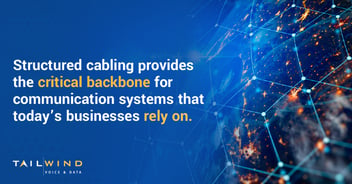Cabling systems for voice and data networks were relatively simple in the past, often consisting only of two-pair or four-pair copper wires that connected devices to a main system. However, as technology advances and businesses grow, these networks are becoming increasingly complex.
More than 50% of network problems can be attributed to low-quality cabling systems,1 including reduced productivity, increased downtime, and higher maintenance costs. To overcome these challenges, enterprise businesses are turning to structured cabling systems. In this blog, we'll discuss the importance of structured cabling and break down its six essential components.
What Is A Structured Cabling System?
Structured cabling is a standardized method of designing and installing a business's telecommunications infrastructure. It involves organizing and managing all the cables, connectors, and hardware required for voice, data, and video systems. Structured cabling is based on standards and guidelines developed by the American National Standards Institute (ANSI) and the Telecommunications Industry Association (TIA).
The ANSI/TIA-568 standards cover various aspects of structured cabling, including cable types, connectors, patch panels, and installation practices. By following these standards, businesses can ensure their cabling infrastructure is reliable, efficient, and scalable. These standards also promote interoperability between different components and systems, making integrating new technologies and equipment easier as the business grows.

Why Is Structured Cabling Important?
Structured cabling can help businesses of all sizes, but it is particularly crucial for multi-location enterprises. As your organization expands operations across different sites, the need for a cohesive and reliable cable infrastructure becomes even more pressing. Structured cabling provides a consistent and organized approach to network design, making it easier to manage and maintain the system across multiple locations.
A structured cabling system uses standardized components and guidelines to ensure your company's networks can support a wide range of voice and data communications equipment. This is true whether you're installing a single coaxial outlet or wiring an entire skyscraper. The components of structured cabling are all designed to meet specific standards for electrical transmission, resistance, cable lengths, connectors, and cable fabrication, making the cable installation process efficient and cost-effective.
The Benefits Of Structured Cabling
Implementing a structured cabling system offers several advantages for businesses, including:
Simplified Management
Structured cabling provides an organized framework for all cabling components, making managing and maintaining the network infrastructure easier. This simplification reduces the time and effort required for moves, additions, changes, troubleshooting, and repairs.
Greater Scalability
As businesses grow, their network needs change. Structured cabling allows organizations to add new telecommunications equipment, users, and applications without significant disruptions or costly upgrades. This scalability ensures the network can accommodate future growth.
Improved Flexibility
Structured cabling supports a wide range of devices and applications, enabling businesses to adapt to new technologies and changing requirements without overhauling their entire network infrastructure.
Increased Reliability
Adhering to structured cabling standards and best practices helps ensure the network's reliability and stability. High-quality components and proper installation techniques minimize signal loss, interference, and downtime, resulting in a more dependable network.
Cost Savings
While the upfront investment in structured cabling may be higher than a piecemeal approach, it can result in significant cost savings over time. Using standardized components can reduce the need for costly upgrades and repairs when it's time to scale the network. Additionally, improved network reliability and performance can lead to increased productivity and reduced downtime, which can positively impact the bottom line.

6 Components Of Structured Cabling Systems
Now that we've explored the primary structured cabling benefits, let's examine its six components. Understanding these elements can help you design a structured cabling system that meets your enterprise's unique needs.
1. Entrance Facilities
Entrance facilities are where external telecommunications cabling enters a building. They are typically dedicated rooms or spaces that house the necessary equipment for connecting the building's network to the outside world. This equipment may include cables, connectors, surge protectors, and grounding systems.
The entrance facilities component is critical for ensuring the security and reliability of the network. It should be designed to protect against physical damage, electromagnetic interference (EMI), and unauthorized access. Proper grounding and bonding are essential to prevent electrical surges and maintain stable network connectivity. Entrance facilities should also have clear documentation and labeling to help technicians quickly identify and troubleshoot issues, minimizing downtime and service disruptions.
2. Equipment Room
The equipment room is the central hub of the structured cabling system. It contains the main cross-connect, which is the point where all the subsystems converge. This room houses network switches, servers, routers, and other core telecommunications equipment.
Equipment rooms should be designed with scalability and flexibility in mind. As the business grows and technology evolves, the equipment room must be able to accommodate new hardware and increased bandwidth requirements. Proper ventilation, cooling, and power management are also crucial to ensure optimal performance and prevent equipment failure.
Make sure to control access to the equipment room to maintain security and prevent unauthorized changes to the network configuration. Additionally, scheduling regular maintenance and updates can keep the equipment running smoothly and help your team proactively address potential issues.
3. Backbone Cabling
Backbone cabling, or vertical cabling, refers to the cables running between entrance facilities, equipment rooms, and telecommunications rooms. These cables are typically high-capacity, such as fiber optic or high-grade copper, and can handle large amounts of data traffic.
Consider your organization's current and future bandwidth requirements when designing the backbone cabling system. Backbone cabling should be able to support the network's expected growth over time without the need for frequent upgrades or replacements. Backbone cabling should be run through dedicated pathways, such as conduits or cable trays, to protect them from damage and interference.

4. Telecommunications Room
Telecommunications rooms are distributed throughout the building and serve as connection points between backbone cabling and horizontal cabling. The telecommunications room houses patch panels, termination blocks, and other equipment necessary for distributing signals to individual workstations.
Carefully plan the location and layout of each telecommunications room to minimize cable lengths and ensure efficient service distribution. Each room should have adequate space, power, and cooling to support the telecommunications cabling and equipment housed within.
Control access to the telecommunications room to prevent unauthorized changes or damage to network equipment. Regular cleaning and maintenance keep the space organized and free of dust and debris, which can interfere with signal quality.
5. Horizontal Cabling
Horizontal cabling connects the cables that run from each telecommunications room to individual outlets or work areas. These are typically copper or fiber optic cables designed to handle the requirements of the devices they connect, such as computers, phones, or printers.
When selecting horizontal cabling, consider the devices and applications that will be using the network. Bandwidth, distance, and interference resistance should be taken into account to ensure optimal performance.
Follow best practices when designing a horizontal cabling system to minimize signal loss and interference. This includes maintaining proper bend radii, avoiding tight bundles, and using appropriate cable terminations. Regularly perform testing and certification to verify the horizontal cabling installation meets industry standards.
6. Work Area
The work area is the final point in the structured cabling system, where end-user devices connect to the network. This typically includes outlets, patch cords, and any necessary adapters or converters.
Well-designed work areas prioritize flexibility and ease of use. Outlets should be placed in convenient locations that are easily accessible for moves, additions, and changes. Patch cables should be of appropriate length and quality to ensure reliable connections.
Labeling and documentation of work area components facilitate troubleshooting and maintenance. Maintain clear and accurate records of outlet locations, cable types, and device connections to help network administrators save time and effort when issues arise.
How These Components Create A Scalable Network
A structured cabling system is designed to provide a scalable and adaptable network that can grow with business needs. The six key components work together to ensure seamless connectivity, high performance, and simplified expansion.
Modular Design For Easy Expansion
Structured cabling follows a modular approach, meaning businesses can add new devices, workstations, or network segments without disrupting the existing infrastructure.
Example: A company expanding to a new floor can integrate additional cabling into the backbone and horizontal cabling systems without rewiring the entire network.
High-Speed Data Transmission Across Multiple Locations
Backbone cabling connects different floors and buildings with fiber optics or high-performance Ethernet cables, ensuring low latency and fast data transfer.
Telecommunications rooms serve as centralized connection points, allowing businesses to reorganize and upgrade networks without affecting user connectivity.
Standardized Cabling For Compatibility & Efficiency
Structured cabling adheres to industry standards (TIA/EIA-568, ISO/IEC 11801), ensuring that different network devices, cables, and hardware remain compatible.
Businesses can switch equipment or upgrade network speeds without needing a complete overhaul.
Improved Network Reliability With Redundancy
Using structured cabling allows organizations to implement failover systems and backup paths, reducing the risk of network outages.
Example: If one telecommunications room experiences downtime, traffic can be rerouted through an alternative cabling route, minimizing disruptions.
Reduced Costs For Future Upgrades
A properly implemented structured cabling system reduces long-term costs by eliminating the need for frequent rewiring or infrastructure changes.
Example: If a company switches from Cat6 to Cat6a or fiber optics, they can upgrade selectively rather than replacing the entire system.
A structured cabling system enables scalability by providing modularity, high-speed transmission, standardization, redundancy, and cost efficiency. Businesses can easily expand their networks without excessive downtime or expenses.
5 Ways Structured Cabling Improves Network Management
A structured cabling system simplifies network administration, troubleshooting, and maintenance, leading to a more efficient and reliable IT infrastructure.
1. Simplifies Troubleshooting & Maintenance
Clear cable organization allows IT teams to quickly locate and resolve issues without untangling messy or undocumented wiring.
Example: If a workstation loses network connectivity, IT personnel can trace the issue back to a specific patch panel or telecommunications room instead of checking every cable manually.
2. Reduces Cable Clutter & Improves Safety
A structured cabling system eliminates excessive cables running across floors, walls, and server rooms, reducing the risk of tripping hazards, overheating, and accidental disconnections.
Example: Using cable trays, patch panels, and labeling systems keeps cables neatly organized and easy to manage.
3. Enables Remote & Centralized Management
Structured cabling supports centralized monitoring, allowing IT teams to remotely diagnose and manage network performance.
Example: Cloud-based monitoring tools can integrate with telecommunications rooms and equipment rooms to detect network congestion or failures in real time.
4. Increases Network Uptime & Stability
Standardized cabling and high-quality infrastructure reduce the likelihood of network failures, interference, or degraded performance.
Example: Using shielded Cat6a cables in a structured cabling system prevents electromagnetic interference (EMI), ensuring consistent data transfer speeds.
5. Makes Office Relocations & Upgrades Easier
Pre-installed structured cabling systems allow businesses to move, upgrade, or reconfigure their networks with minimal downtime.
Example: If a company relocates, IT teams can reconnect workstations without reconfiguring the entire network, saving time and resources.
Structured cabling enhances network management by simplifying troubleshooting, reducing clutter, supporting remote monitoring, increasing uptime, and making upgrades easier. Businesses benefit from faster issue resolution, improved safety, and a more organized IT infrastructure.
Tailwind: Your Trusted Enterprise Structured Cabling Provider
As businesses continue to rely on technology to drive growth and innovation, the importance of a reliable network infrastructure cannot be overstated. Structured cabling greatly simplifies the complexity of modern voice and data networks, providing a scalable, manageable solution for enterprise companies.
With TailWind as your strategic partner for everything from structured cabling design to ongoing support, you'll never have to worry about wiring for your multi-location enterprise. We deliver complete accountability for your OSP or fiber network install, with services and solutions tailored to meet your organization's specific needs.
Ready to learn more about how our structured cabling experts can simplify your enterprise IT? Reach out to TailWind today.
Sources:


